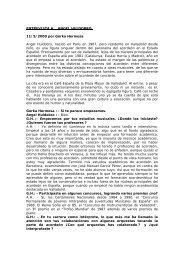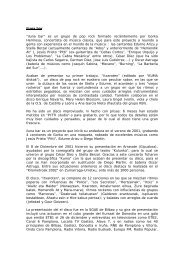The Accordion in the 19th Century - Gorka Hermosa
The Accordion in the 19th Century - Gorka Hermosa
The Accordion in the 19th Century - Gorka Hermosa
Create successful ePaper yourself
Turn your PDF publications into a flip-book with our unique Google optimized e-Paper software.
entitled <strong>Accordion</strong> Essay: <strong>The</strong> Touch<strong>in</strong>g Story of George Wash<strong>in</strong>gton`s Boyhood<br />
(1867). [120, 121, 122, 123, 124]<br />
Fig. 105: John Kimmel 204 . Fig. 106: Photograph of Fig. 107: Mark Twa<strong>in</strong> 205<br />
R.N. Keely (c.1846) 206 .<br />
COLOMBIA:<br />
<strong>The</strong> first known accordionist was<br />
Francisco Moscote (1848-1953); he was<br />
also a s<strong>in</strong>ger and composer of numberless<br />
songs. He created <strong>the</strong> vallenato style. [40,<br />
89, 298, 419]<br />
ARGENTINA: Fig. 108: Francisco Moscote 207 .<br />
Around 1852, <strong>the</strong> accordion started to be used to perform marches on <strong>the</strong> ships<br />
of <strong>the</strong> Argent<strong>in</strong>ian navy, to that date, <strong>the</strong> notes of <strong>the</strong> National An<strong>the</strong>m and o<strong>the</strong>r<br />
marches had been sung a capella [141]. <strong>The</strong> Afroamerican José Santa Cruz (circa 1860-?)<br />
was a pioneer of Argent<strong>in</strong>ian folk, perform<strong>in</strong>g polkas and mazurkas (basic rhythms of<br />
<strong>the</strong> chamamé) at <strong>the</strong> accordion. Later on, he replaced <strong>the</strong> accordion for <strong>the</strong> bandoneon<br />
and he was <strong>the</strong> fa<strong>the</strong>r of <strong>the</strong> well-known bandoneon player Dom<strong>in</strong>go Santa Cruz (1884-<br />
?). [40, 227, 299]<br />
BRAZIL:<br />
German immigrants <strong>in</strong>troduced <strong>the</strong> accordion <strong>in</strong> 1845; its presence was<br />
noteworthy among <strong>the</strong> 2000 German soldiers who disembarked <strong>in</strong> 1851 <strong>in</strong> Brazil, hired<br />
to fight <strong>the</strong> Argent<strong>in</strong>ian dictator Manuel Rozas. When <strong>the</strong> war f<strong>in</strong>ished, many of <strong>the</strong>se<br />
soldiers stayed <strong>in</strong> Brazil, mak<strong>in</strong>g <strong>the</strong> accordion popular <strong>in</strong> <strong>the</strong>se lands. <strong>The</strong> first<br />
documented mention of <strong>the</strong> traditional Brazilian accordion (sanfona de 8 baixos) is<br />
from 1875, when an <strong>in</strong>strument with eight basses was <strong>in</strong>troduced by Italian immigrants.<br />
In <strong>the</strong> south of <strong>the</strong> country, <strong>the</strong> accordion started to settle at <strong>the</strong> end of <strong>the</strong> 19 th c. as solo<br />
204 Photograph taken from <strong>the</strong> CD Virtuoso of <strong>the</strong> Irish accordion John Kimmel (1980). Fig. taken from:<br />
http://www.worldmusicstore.com/virtuosoof<strong>the</strong>irishaccordion1980johnkimmelcd.aspx<br />
205 Fig. taken from: http://es.wikipedia.org/wiki/Mark_Twa<strong>in</strong><br />
206 One of <strong>the</strong> first photographs of an accordion. It was taken <strong>in</strong> Philadelphia (USA). Fig. taken from:<br />
http://www.musurgia.com/products.asp?ProductID=2304&CartID=5219402222009<br />
207 Fig. taken from: http://wwwpartacordeon.blogspot.com/2011/02/biografia-de-grandes-acordeoneros.html<br />
46




